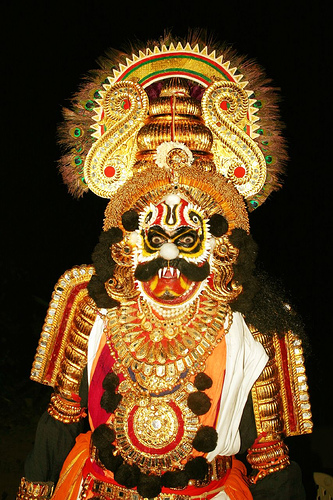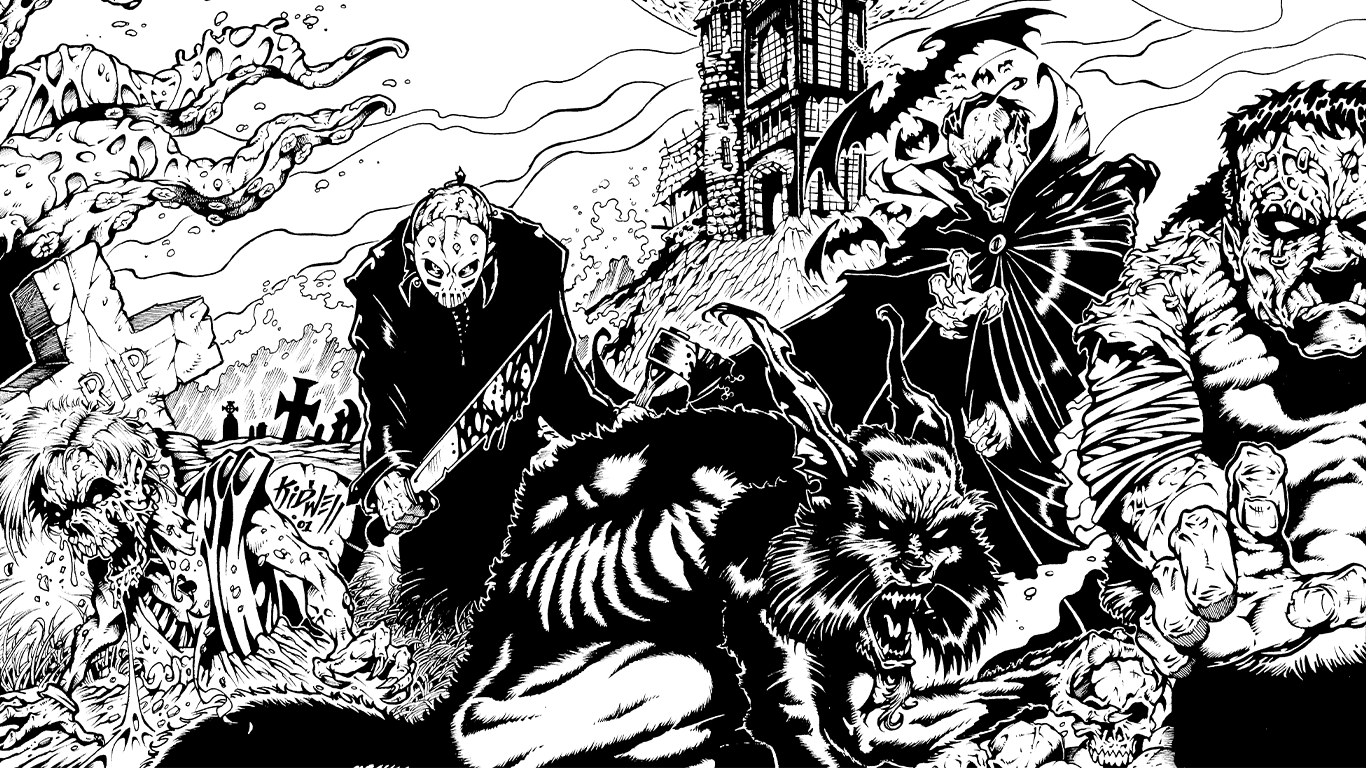We may earn money or products from the companies mentioned in this post.
Also Known As: Asura, Kravyads, Nri-chakshas, Kravyads. Female rakshasas are known as Rakshasi.
Description: Rakshasas are encountered in one of two states: either possessing a human (or occasionally an animal) or as semi-corporeal spirit entities. Since are capable of magically altering the appearance of their spirit form at will, the natural appearance of these creatures is unknown.
BMA Classification: Rakshasas are classified as monster by the Bureau of Monster Affairs. However, when they are possessing a human body, the host is still human and should therefore be harmed only as a last resort.
 Powers: Rakshasas can magically alter their appearance and make themselves invisible using illusion magic similar to that used by fairies. Some are also versed in the use of ritual magic. A rakshasa can only be killed by destroying its spirit form.
Powers: Rakshasas can magically alter their appearance and make themselves invisible using illusion magic similar to that used by fairies. Some are also versed in the use of ritual magic. A rakshasa can only be killed by destroying its spirit form.
Vulnerabilities: A rakshasa’s human host can be injured normally, but the entity itself is only harmed by holy weapons. If the host body is killed before the rakshasa, the rakshasa reverts to its spirit form. A rakshasa may also be cast out of its host body with an exorcism or similar ritual. In spirit form, Rakshasas are relatively weak and have difficulty interacting with the material world.
Biology and Habitat: Due to the long mythological history of the rakshasa and the very small number of rakshasas encountered by M-Forcers (only three since the organization was founded), current knowledge of the creature is highly speculative. Rakshasas have a taste for human flesh, but vampire-like attacks prior to rakshasa activity suggest that only blood is required for the creature to remain in our world.
Some stories say that rakshasas are reincarnations of wicked humans, but most modern scholars believe them to be extra-dimensional creatures. Noted occultist Hunter Constantine has theorized that it’s easier for a rakshasa to possess a willing host, and that the “bad people become rakshasas” belief comes from the fact that “the nefarious, the bestial, and the depraved are naturally more susceptible to the machinations of the they type of filth that from time to time oozes up from the lower dimensions.”
Once a rakshasa has possessed a host, the host body stops aging and can live indefinitely as long as the rakshasa continues to reside within. The rakshasa prefers to eat raw meat (especially human flesh), but can also survive on spoiled food other types if meat is unavailable. Uncontaminated food and cooked meat tend to make rakshasas ill.
Rakshasa seem to take great offense to religion, and are known to disturb sacrifices, harass holy men, and desecrate graves and holy sites.
Sightings: Most accounts of rakshasa come from mythology and folklore, and therefore have questionable informational value. M-Forcers have encountered rakshasas on three different occasions: New Orleans in 1963; San Jose, California in 1987; and Plano, Texas in 2005.
Additional Information: The Sanskrit epic Ramayana describes the rakshasas encountered by Hanuman in the city of Lanka:
“the rakshasas sleeping in the houses were of every shape and form. Some of them disgusted the eye, while some were beautiful to look upon. Some had long arms and frightful shapes; some were very fat and some were very lean; some were mere dwarfs and some were prodigiouslytall. Some had only one eye and others only one ear. Some had monstrous bellies, hanging breasts, long projecting teeth, and crooked thighs; whilst others were exceedingly beautiful to behold and clothed in great splendour. Some had two legs, some three legs, and some four legs. Some had the heads of serpents, some the heads of donkeys, some the heads of horses, and some the heads of elephants.”
Game Information
When possessing a human, the rakshasa uses the host’s Body Number. If the host’s Brain or Nerve Number is higher than the Rakasha’s he may also use that Number instead of his own. The rakshasa has access to all of the host’s memories and knowledge and can use any Job or Skill that the host possesses. Whether or not the rakshasa may use the host’s Gimmick(s), and whether it is affected by the host’s Weakness(es) depends on the nature of the Gimmick or Weakness and is determined by the GM on a case-by-case basis.
The monster’s stats in spirit form are:
Body: 5
Brain: 15
Nerve: 14
Job: Evil Spirit (13); Some rakshasa also have a magic-related Job (Number determined by GM)
Gimmick: Alter Appearance (15)–The rakshasa may take on the appearance of any person or creature he has seen. He may also use this Gimmick to become invisible. If the rakshasa fails its roll, there is something imperfect about the illusion, which can be noticed by anyone who makes a successful Brain roll. If the Gimmick roll succeeds, the illusion will only be found out if the witness suspects rakshasa activity and rakshasa does something out of character (as determined by the GM, based on how familiar the witness is with the person or creature being impersonated). If both conditions are met, the witness may make a Brain roll against the rakshasa’s Gimmick roll in order to realize that something is amiss. Weapons and physical attacks that are part of an illusion cause damage normally, but the damage disappears if the Riakshasa is killed or the victim disbelieves.
Weaknesses: Holy Weapons (12)–When a rakshasa who is possessing a human takes damage from a blessed weapon, the creature must make a Weakness roll. If the Weakness takes effect, 2/3 of the damage is applied to the rakshasa, with the remainder going to the host body. This Weakness does not apply to rakshasas in spirit form. Only blessed weapons trigger this Weakness–holy water, religious symbols, and the like have no unusual effect on rakshasas.
Semi-Corporeal (12)–When in spirit form, the rakshasa must overcome this Weakness in order to interact with the physical world in any way.
Requires Blood (16)–When in spirit form, the rakshasa requires blood to survive. If a rakshasa goes more than a week without feedng, it must make a Weakness roll. If the Weakness takes effect, it loses 1 point of Body. When the rakshasa’s Body reaches zero, it is banished back to its native plane of existence.
Skills: Religious Practices +3; Subterfuge +2
Other Traits: When in spirit form, the rakshasa can only be harmed with a holy weapon.
If a rakshasa eats cooked meat or uncontaminated food, it must make a Nerve roll to avoid throwing up.
Armor Rating: NA
Damage Bonus: NA
HP: 15
Yum Yums: 3
Possession
In order to possess a human, the rakshasa must first feed on its prospective host’s blood for at least five consecutive nights. To feed on a host, the rakshasa must roll against his “Semi-Corporeal” Weakness. If the Weakness takes effect, the rakshasa fails to fully materialize and risks awakening the intended victim (the victim may make a Brain roll to wake up). If the victim wakes up, the rakshasa will turn invisible and flee. If the victim remains asleep, the rakshasa may try again, but its Weakness Number goes up by 1 for each failed attempt.
If the rakshasa avoids the Weakness, he manages to materialize well enough to sink his fangs into the victim’s neck, releasing a venom that keeps the victim in a state of deep sleep for at least an hour. Once the victim is comatose, the rakshasa drinks his blood, leaving two small puncture wounds. Each time the rakshasa feeds, the victim must make a Body roll. If the roll fails, the victim loses 2 points of Body and 1 point of Nerve. Lost Body points cannot be regained until the rakshasa stops feeding, at which point they are recovered at the rate of 1 per week. Lost Body and Nerve points will make the victim increasingly weak and listless, which, along to with the bite wounds, often make the rakshasa’s activity look like a vampire is feeding on the victim.
Once the rakshasa has fed on the victim for five consecutive nights, he may attempt to possess the victim during the night of any new moon for as long as the victim lives. Possession requires a resisted Nerve roll and can only be attempted once per night. The victim will experience a failed possession attempt as an extremely vivid nightmare or episode of sleep paralysis.
Exorcism
An exorcism is handled very much like combat:the exorcist makes the appropriate roll, resisted by the rakshasa’s Job. The “damage” from an exorcism is applied to the loser’s Nerve Number rather than Health Points. If the exorcist’s Nerve reaches zero, he dies. If the rakshasa’s Nerve reaches zero, it is forced out of the host body and immediately regains 1/2 its Nerve points. Once the rakshasa has left the host, reducing its Nerve to zero will banish it from our world. Human regain lost Nerve points at the rate of 1 per day of relative peace and quiet.
When a rakshasa leaves a host body (either because of death or exorcism), the GM should decide whether the body has lived beyond its normal lifespan (if necessary, multiply the host’s Body by 5 and add 2d20 to determine the age at which he or she would have died of old age). If the answer is “yes,” the former host must make an immediate Body roll or die instantly.



